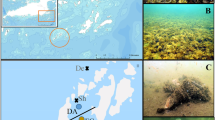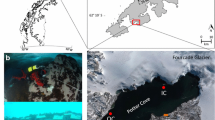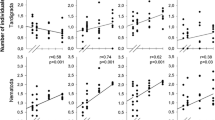Summary
The cover of foliose algae is sparse to non-existent above a low-level algal zone on many shores in N.S.W., except in rock-pools. Above this algal zone, encrusting algae, mostly Hildenbrandia prototypus, occupy most of the primary substratum on sheltered shores. Experimental manipulations at midtidal levels were used to test hypotheses about the effects of grazing by molluses and of physical factors during low tide on this pattern of algal community structure.
Fences and cages were used to exclude grazers: molluscs grazed under roofs and in open areas. Cages and roofs provided shade, and decreased the harshness of the environment during low tide: fences and open areas had the normal environmental regime.
In the absence of grazers, rapid colonization of Ulva and slower colonization by other foliose algae occurred in all experimental areas. The rate of colonization by Ulva sporelings was initially retarded on existing encrusting algae, but after a few months, cover of Ulva equalled that on cleared rock.
Most species of algae only grew to maturity inside cages, and remained as a turf of sporelings inside fences. No foliose algae grew to a visible size in open, grazed areas. Grazing thus prevents the establishment of foliose algae above their normal upper limit on the shore, but the effects of physical factors during low tide prevent the growth of algae which become established when grazers are removed. Physical factors thus limit the abundance of foliose algae at mid-tidal levels.
The recolonization of cleared areas by Hildenbrandia was not affected by the presence of a turf of sporelings, nor by the shade cast by roofs, but was retarded in cages where mature algae formed a canopy. Even under such a canopy, Hildenbrandia eventually covered as much primary substratum as in open, grazed areas. This encrusting alga is able to escape from the effects of grazing by having a tough thallus, and by its vegetative growth which allows individual plants to cover a lot of substratum, and by the tendency for new individuals to start growing from small cracks and pits in the rock, which are apparently inaccessible to the grazers.
Mature foliose algae are removed from the substratum by waves, and many individual plants died during periods of hot weather. Sporelings in a turf were eliminated, after experimental fences were removed, by the combined effects of macroalgal grazers, which invaded the areas, and microalgal grarers which ate the turt from the edges inwards.
The results obtained here are discussed with respect to other studies on limits to distribution of intertidal macroalgae, and the role of grazing in the diversity and structure of intertidal algal communities. Some problems of these experimental treatments are also discussed.
Similar content being viewed by others
References
Aitken JJ (1962) Experiments with populations of the limpet Patella vulgata D. Irish Nat J 14:12–15
Baker SM (1909) On the causes of the zoning of brown seaweeds on the seashore. New Phytol 8:196–202
Burrows EM, Lodge SM (1950) A note on the inter-relationships of Patella, Balanus and Fucus on a semi-exposed coast. Mar Biol Sta Pt Erin Is Man Ann rep 62:30–34
Castenholz RW (1961) The effect of grazing on marine littoral diatom populations. Ecology 42:783–794
Chapman ARO (1973) A critique of prevailing attitudes towards the control of seaweed zonation on the seashore. Bot Mar 41:80–82
Cheney DD, Mathieson AC (1978) On the ecological and evolutionary significance of vegetative reproduction in seaweeds. J Phycol 14:27
Connell JH (1970) A predator-prey system in the marine intertidal region. I. Balanus glandula and several predatory species of Thais. Ecol Monogr 40:49–78
Connell JH (1972) Community interactions on marine rocky intertidal shores. Ann Rev Ecol Syst 3:169–192
Connell JH, Slatyer RO (1977) Mechanisms of succession in natural communities and their role in community stability and organization. Am Nat 111:1119–1144
Conover JT, Sieburth JMcN (1966) Effect of tannins excreted from Phaeophyta on planktonic animal survival in tide pools. Proc. Vth internat. Seaweed Symp. 1965. Halifax, Canada, Pergamon Press, Oxford. pp 99–100
Creese RG (1978) Ecology and reproductive biology of intertidal limpets. Unpublished Ph.D. Thesis, University of Sydney
Dayton PK (1971) Competition, disturbance and community organization: the provision and subsequent utilization of space in a rocky intertidal community. Ecol Monogr 41:351–389
Dayton PK (1975) Experimental evaluation of ecological dominance in a rocky intertidal algal community. Ecol Monogr 45:137–159
Denley EJ, Underwood AJ (1979) Experiments on factors influencing settlement, survival and growth of two species of barnacles in New South Wales. J exp mar Biol Ecol 36:269–293
Doty MS (1946) Critical tide factors that are correlated with the vertical distribution of marine algae and other organisms along the Pacific Coast. Ecology 27:315–328
Frank PW (1965) The biodemography of an intertidal snail population. Ecology 46:831–844
Hatton H (1932) Quelques observations sur le peuplement en Fucus vesiculosus des surfaces rochenses denudées. Mus Hist Nat Lab Mar Bull 9:1–6
Hatton H (1938) Essais de bionomie explicative sur quelques especes intercotidales d'algues et d'animaux. Ann Inst Oceanogr Monaco 17:241–348
Hay C (1979) Some factors affecting the upper limit of the southern bull kelp Durvillaea antarctica (Chamisso) Hariot on two New Zealand shores. J Roy Soc N Z 9:279–289
Hruby T, Norton TA (1979) Algal colonization on rocky shores in the Firth of Clyde. J Ecol 67:65–77
Jones NS (1948) Observations and experiments on the biology of Patella vulgata at Port St. Mary, Isle of Man. Proc Trans Liverpool Biol Soc 56:60–77
Kain JM, Jones NS (1966) Algal colonization after removal of Echinus. Proc. Vth Internat. Seaweed Symp. 1965. Halifax, Canada. Pergamon Press Oxford. pp 139–140
Lewis JR (1964) The ecology of rocky shores. English Universities Press, London
Lodge SM (1948) Algal growth in the absence of Patella on an experimental strip of foreshore Port St. Mary, Isle of Man. Proc Trans Liverpool Biol Soc 56:78–83
Lubchenco J (1978) Plant species diversity in a marine intertidal community: importance of herbivore food preference and algal competitive abilities. Am Nat 112:23–39
Lubchenco J, Menge BA (1978) Community development and persistence in a low rocky intertidal zone. Ecol Monogr 48:67–94
May V, Bennett I, Thompson TE (1970) Herbivore-algal relationships on a coastal rock platform (Cape Banks, N.S.W.). Oecologia 6:1–14
Menge BA (1976) Organization of New England rocky intertidal community — role of predation, competition and environmental heterogeneity. Ecol Monogr 46:355–394
Moore HB (1939) The colonization of a new rocky shore at Plymouth. J Anim Ecol 8:29–38
Ottaway JR (1973) Some effects of temperature, desiccation and light on the intertidal anemone Actinia tenebrosa Farquhar (Cnidaria: Anthozoa). Aust J mar Freshwat Res 24:103–126
Paine RT, Vadas RL (1969) The effects of grazing by sea urchins, Strongylocentrotus spp. on benthic algal populations. Limnol Oceanogr 14:710–719
Pyefinch KA (1943) The intertidal ecology of Bardsey Island, North Wales, with special reference to the recolonization of rock surfaces and the rock pool environment. J Anim Ecol 12:82–108
Raffaelli D (1979) The grazer-algae interaction in the intertidal zone on New Zealand shores. J exp mar Biol Ecol 38:81–100
Rees TK (1940) Algal colonization at Mumbles Head. J Ecol 28:403–437
Schonbeck M, Norton TA (1978) Factor controlling the upper limits of fucoid algae on the shore. J exp mar Biol Ecol 31:303–314
Sieburth JMcN, Conover JT (1966) Antifouling in Sargassum natens: Re-recognition of tannin activity. Proc. Vth Internat. Seaweed Symp. 1965. Halifax, Canada. Pergamon Press, Oxford. p 207
Southward AJ (1964) Limpet grazing and the control of vegetation on rocky shores. In: Crisp DJ (ed) Grazing in terrestrial and marine environments. Blackwell Oxford. pp 265–273
Underwood AJ (1975) Intertidal zonation of prosobranch gastropods: analysis of densities of four coexisting species. J exp mar Biol Ecol 19:197–216
Underwood AJ (1976) Nearest neighbour analyses of spatial dispersion of intertidal gastropods within two substrata. Oecologia 26:257–266
Underwood AJ (1978) An experimental evaluation of competition between three species of intertidal gastropods. Oecologia 33:185–208
Underwood AJ (1980) Structure of a rocky intertidal community in New South Wales: patterns of vertical distribution and seasonal changes. (submitted paper)
Vadas RL (1977) Preferential feeding — optimization strategy in sea urchins. Ecol Monogr 47:337–372
Vance RR (1979) Effects of grazing by the sea urchin Centrostaphanus coronatus on prey community composition. Ecology 60:537–546
Author information
Authors and Affiliations
Rights and permissions
About this article
Cite this article
Underwood, A.J. The effects of grazing by gastropods and physical factors on the upper limits of distribution of intertidal macroalgae. Oecologia 46, 201–213 (1980). https://doi.org/10.1007/BF00540127
Received:
Issue Date:
DOI: https://doi.org/10.1007/BF00540127




